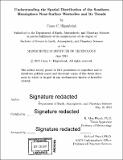| dc.contributor.advisor | R. Alan Plumb. | en_US |
| dc.contributor.author | Hilgenbrink, Casey C | en_US |
| dc.contributor.other | Massachusetts Institute of Technology. Department of Earth, Atmospheric, and Planetary Sciences. | en_US |
| dc.coverage.spatial | xc----- | en_US |
| dc.date.accessioned | 2018-03-12T19:31:01Z | |
| dc.date.available | 2018-03-12T19:31:01Z | |
| dc.date.copyright | 2015 | en_US |
| dc.date.issued | 2015 | en_US |
| dc.identifier.uri | http://hdl.handle.net/1721.1/114127 | |
| dc.description | Thesis: S.B., Massachusetts Institute of Technology, Department of Earth, Atmospheric, and Planetary Sciences, 2015. | en_US |
| dc.description | Cataloged from PDF version of thesis. | en_US |
| dc.description | Includes bibliographical references (pages 62-63). | en_US |
| dc.description.abstract | In some experiments in which idealized general circulation models (GCMS) are used to study the tropospheric response to stratospheric perturbations, the tropospheric response is much stronger and longer-lived compared to observations (e.g., Polvani and Kushner 2002, Kushner and Polvani 2004). Chan and Plumb (2009) found that those experiments which exhibited particularly long tropospheric decorrelation times (and, by the fluctuation dissipation theorem, much stronger annular mode responses) were marked by bimodality in the distribution of the latitude of surface zonal-mean zonal winds. Here, ERA-Interim and NCEP/NCAR reanalysis data are used to establish if this bimodality exists in the Southern Hemisphere (SH) near-surface winds, which would predict the existence of an additional mode of tropospheric variability exhibiting stronger and longer-lived responses than what has previously been observed. Histograms of the latitudinal position of maximum near-surface zonal-mean zonal winds turn up no convincing evidence of jet bimodality, although they do reveal an interesting - but probably spurious trimodality in the NCEP/NCAR June-August 850-hPa distribution of jet latitude. A climatology of wintertime zonal winds reveals that there is a time-mean split jet over the South Pacific Ocean; furthermore, empirical orthogonal function analysis reveals that, over the South Pacific, the dominant mode of wintertime zonal wind variability is a splitting and un splitting of the jet. Ultimately, both the climatological split jet and its variability are determined not to be evidence of jet bimodality. The temporal trends in the distribution of near-surface jet latitude are also examined. Stratospheric ozone depletion has been implicated in surface circulation changes in the SH high latitudes; one of these changes has been a poleward shift of the jet in austral summer. In this thesis, it is found that a poleward shift of the December-February distribution of jet latitude has taken place from the pre-ozone-hole to ozone-hole eras, consistent with previous findings. The novel result is that there has also been a poleward shift of this distribution in May, which is consistent with a secondary maximum in ozone depletion near the tropopause in April-May as observed by other authors (Thompson et al. 2011), and would imply the occurrence of troposphere-stratosphere coupling in late fall. An in-depth investigation of these May zonal wind trends will be pursued in future work. | en_US |
| dc.description.statementofresponsibility | by Casey C. Hilgenbrink. | en_US |
| dc.format.extent | 63 pages | en_US |
| dc.language.iso | eng | en_US |
| dc.publisher | Massachusetts Institute of Technology | en_US |
| dc.rights | MIT theses are protected by copyright. They may be viewed, downloaded, or printed from this source but further reproduction or distribution in any format is prohibited without written permission. | en_US |
| dc.rights.uri | http://dspace.mit.edu/handle/1721.1/7582 | en_US |
| dc.subject | Earth, Atmospheric, and Planetary Sciences. | en_US |
| dc.title | Understanding the spatial distribution of the Southern Hemisphere near-surface westerlies and Its trends | en_US |
| dc.type | Thesis | en_US |
| dc.description.degree | S.B. | en_US |
| dc.contributor.department | Massachusetts Institute of Technology. Department of Earth, Atmospheric, and Planetary Sciences | |
| dc.identifier.oclc | 1027723386 | en_US |
